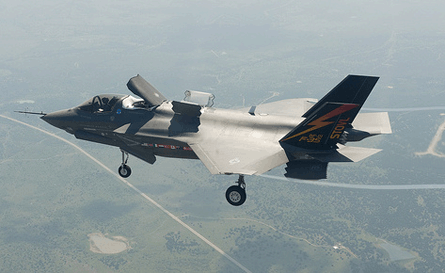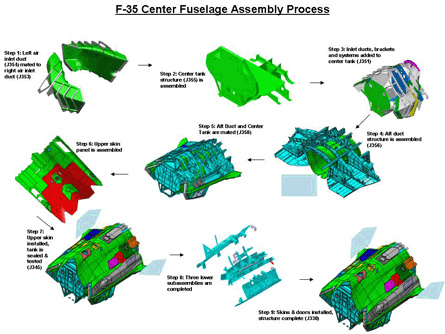US government auditors monitoring the F-35 Joint Strike Fighter programme have warned that Lockheed Martin expects delays of aircraft deliveries will continue for at least another year.
The Defense Contracts Management Agency (DCMA) also has expressed fears Lockheed Martin will never fully recover, citing parts shortage trends indicating the F-35 assembly line in Fort Worth, Texas, "will not be able to achieve or sustain [full] rate production".
Both statements are contained inside hundreds of pages of monthly assessment reports prepared by the DCMA's Fort Worth staff for the F-35 joint programme office.
 |
|---|
© Lockheed Martin |
The redacted documents, posted on the DCMA's website in response to Freedom of Information Act requests, reveal a manufacturing system plagued since at least July 2007 by parts shortages and unexpectedly high design changes. The reports catalogue short bursts of progress followed by months of new delays.
The DCMA's documents have emerged at the same time as the Department of Defense has confirmed a 13-month schedule slip for the development phase and the US Air Force has announced a two-year delay for the F-35A's in-service date.
Both events are now expected in fiscal year 2015, with full rate production delayed one year to FY2016. Meanwhile, the US Marine Corps still plans to have the F-35B enter service in FY2012.
As of October 2009, according to the DCMA's reports, Lockheed's plans showed the biggest cause of production delays - now ranging between four and six months - would persist through the second lot of low rate initial production (LRIP-2).
Severe shortages of parts have forced Lockheed to send incomplete wings to a mating fixture, which joins the four major wing structures to the fuselage. Even after the missing parts arrive, finishing the wings inside the mating fixture is more difficult, which extends the delay.
Lockheed has previously said that many of the parts shortages were caused by the 2004 redesign. As part of an effort to save up to 1,360kg (3,000lb), Lockheed introduced stricter manufacturing tolerances knowing many suppliers would need several years to achieve them.
 |
|---|
The continued delays, however, raise questions about Lockheed's claims of manufacturing efficiency.
For several years, the company has touted its decision to use the same tooling for both development and production aircraft, claiming the strategy would accelerate learning curves and enable a fast-paced schedule in which hundreds of aircraft are built during the flight-test phase.
The October report by the DCMA says Lockheed has targeted the BF-13 airframe - one of the first LIRP-3 aircraft due for delivery in 2011 - to eliminate the "wing at mate overlap" problem, meaning all the wing's parts should arrive on time.
In response to questions, Lockheed now says the problem could be solved even faster. The most recent wing structure delivered to the mate fixture was 90% complete.
"We are now moving more of the wing/mate overlap work to the in-station wing build," Lockheed says, "but doing so in an orderly fashion."
Meanwhile, the programme's overall schedule is expected to be changed for the sixth time. The programme adopted master schedule 6.1 in May 2008 in response to delivery delays, then quickly fell behind again. DCMA's monthly reports show Lockheed average completion rate slipped to 40% over the next 12 months.
Lockheed is now "working with the government to get agreement" on the latest schedule revision - MS6.2, it says.
Stretching out the schedule could fail again unless Lockheed dramatically changes how it deals with suppliers. The DCMA report dated April 2009 criticises Lockheed for late delivery of common components needed by its suppliers.
 |
|---|
"While some positive results have occurred, the overall procedures used by Lockheed Martin to provide common components to its second tier suppliers are inefficient and will not be sustainable in later LRIP contracts," the report says.
In addition to Lockheed's own failures, the monthly reports reveal a series of unexpected surprises throughout the supply chain that caused production disruptions.
Problems included a misplaced keel beam for BF-3 in August 2007, an ejection seat test failure in December 2008 and cracking that shut down a 50,000t press in Cleveland for six months.
Meanwhile, the DCMA reports consistently cited problems with the F-35's aft fuselage and empennage supplier. The company's identity was redacted in the reports, but the supplier is thought to be BAE Systems.
BAE says it is on track to start delivering aft fuselage and empennage sections on schedule by April, as forecasted in the DCMA monthly report.
"Historical delays experienced with the programme related to issues associated with the supply of hard metal [titanium] structures," BAE says. "These issues have now been overcome and the programme has now been recovered."
- For the full presentation click here
- The DEW-Line: DCMA reports reveal glimpses inside F-35 production delays
Source: Flight International



















